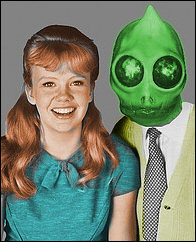Thanks to bloggers, Entourage and Smallville, Aquaman has been getting some respect lately. Quite a change from the sammich-making joke he was made to be over the last few years. He might be cool now in an ironic way but Aquaman still has a pretty lame name and a weak-looking logo. For a cool name and logo Artie can't hold a lantern-fish to the Harvey comics water-based hero of the 1960's, The Pirana.
The writer had guts not to name a water-villain after a sea animal like everyone else does. Where Aquaman fights villains like 'Shark' Norton and Black Manta, the Pirana battles the Human Anchor, a foe who's power is to sit underwater and keep a boat from drifting!
The Pirana also matched wits with Brainstorm, the Thinking Man's Villain! Brainstorm is so smart his forehead sparks! You have to be hard core to take out a guy like that. Aquaman couldn't stop a guy who wore scuba gear and talked funny from killing his son.
The Pirana would never let his kingdom be taken away from him because he kicks ass! His costume also has a camoflauge pattern just like Aquaman had in his 1980's mini, but it is a manly green instead of ballet-dancer blue.
Let's look at those logos...
It's a moist Star Trek symbol.
Cool. How many logos have teeth? This logo is shaped like a scary fish and it says to me "I Will Tear You A New One". This logo looks really ticked off.
The Pirana has eels for friends named Bara and Cuda who assist him in his adventures. Aquaman has a seahorse for a pal. Male seahorses get pregnant and give birth. Giant eels have giant sharp teeth and can rip out large chunks of flesh when they chomp your face. Eels are cooler than seahorses.
Pirana: 1
Aquaman: 0
Sunday, October 23, 2005
Thrill-O-Rama fearlessly presents - The PIRANA
Posted by
Sleestak
at
10/23/2005 07:01:00 PM
![]()
![]()
Subscribe to:
Post Comments (Atom)



























I love old, obscure comic book logos that haven't survived to this day sop they appear new and original. Someday I think I should build a blog entirely around discussing them...hmmmmm...
ReplyDeleteLook at how old the Action Comics logo is...
ReplyDeleteI don't care: it's a Harvey superhero comic, it's by definition uncool.
ReplyDeleteEven compared to Aquaman.
You have a point about their hero lines. One of the things people forget is that it wasn't EC or the others that prompted the congressional backlash against comics. Initially it was Harvey Comics due to their violent and extreme nature. Harvey survived for a time when others did not by bending and changing to a juvenile line. Unfortunatley, when times changed to allow a return to a woder audience harvey was unable to adapt and produced work that was, even for the 60's, nearly uniformly poor.
ReplyDeleteHarvey's Juvenile Line
"Harvey Comics, a long-vanished publisher whose properties evoke recent memories mainly through the occasional film adaptation and through business and lawsuit stories about the ownership of their out-of-print concepts, once sold a large number of books aimed at younger readers.
Richie Rich, Baby Huey, Casper, Spooky, Hot Stuff, and connected spin-offs represented the backbone of their line. These pieces usually centered around characters one might understand to belong to a prepubescent age group (at least, anatomical conventions, particularly those of head-size-to-body-ratios, imply as much). Even the brogdignagian Baby Huey, a 200-pound duckling, fits this emphasis on very young protagonists. By using young heroes, Harvey targeted young readers, something which crosses contemporary comics taboos. Consider, for instance, the pejorative statement claiming a comic aims at "babies" (yes, used as an insult term rather than literally). One often hears a piece accused of pandering to "babies" for offenses like failing to contain profanity, enough graphic violence, or enough implied or explicit sex. That much louder we can expect critics to bellow when a piece specifically aims at younger readers rather than an all-ages crowd or thirtysomething adolescents.
Generally inoffensive by design, and featuring a mild slapstick humor and humor of situation, such pieces paid no homage to the idols that would come to drive comics in later decades: the cult of cool, the fad of the moment, and the dubious process of demonstrating "relevance" by morbidly dwelling on the ugly side of human nature did not, as a rule, intrude into these pieces. They never intended to disturb, and a later generation, much given to aesthetic theories that condemn anything that doesn't offend, frequently targeted Harvey pieces for an unkind and sometimes unfair derision.
The Harvey formula, more or less, owed to perhaps a generation of funny-animal comics (although pieces like Richie Rich technically dealt with human characters) and not from some conspiratorial rejection of mainstream comics values. Changing tastes and an increasingly draconian lock of a single editorial model on all comics, across genre and publisher, pushed these pieces to a peripheral place in the industry, and, eventually, like other non-superhero pieces, the line expired."